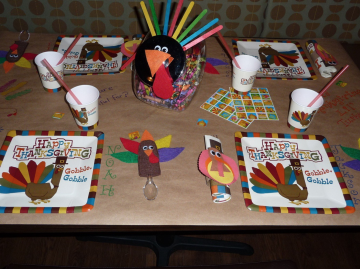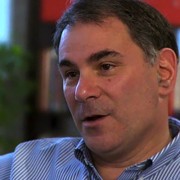Kaplan: The Kids’ Table
Monday, November 20, 2017

These days, I do get to sit at some main tables, but I try to stay mindful of whose voices aren’t being heard there-particularly when they are young and presumed not to have anything to add. I feel this most acutely in the debates around education reform. We keep kids off to the side while the adults talk and talk and talk about how to improve student experience and outcomes. And there’s another similarity to Thanksgiving meals: a lot of loud conversation and not much action! The talk at the grownup table never stops, yet year after year the education system in the US continues to atrophy and our students fall further behind the global curve. Every 29 seconds in America another student gives up on school, adding up to nearly a million high school dropouts a year.
What if we put students at the center of the education transformation conversation? Could we get past our suspicion that they would make ignorant or irresponsible suggestions, and tap into what they know better than any of us: what works for them as learners? If we engaged kids in the problems facing schools, and gave them access to design tools, they might imagine a learning experience they would be more likely to engage in and commit to. What if we didn’t stick our youth at the kid’s table?
The notion of bringing kids into the conversation about what serves them best is beginning to take hold in various quarters. Ellen Galinsky did it in the midst of a cultural debate on whether children were better or worse off when their mothers entered the workforce. The audacious approach of her study became the title of her book Ask The Children. Architects who design the places where kids spend their time are doing more asking, too. Check out, for instance, these photos of the Erika-Mann Grundschule II in Amsterdam. “The school’s recently revamped environment is amazing, perhaps not surprisingly as it was designed by the kids themselves”
Here at the Business Innovation Factory (BIF), our Student Experience Labhas a growing portfolio of projects guided by a simple and powerful question, What if we trusted and enabled students to design their own education future? A future that learners were personally excited about and committed to. The big aha from over twelve years of facilitating education design studios at BIF is the imperative to enable student agency. We must put students in the drivers seat and view our role, the role of adults, as catalysts.
In a representative education design studio at BIF we invited 40 students aged 12–22 who travelled to BIF in Providence from all corners of Rhode Island’s public education system to explore and demonstrate the power of student agency. Right at the start of the day it was announced that there would be a kids’ table, but guess who was relegated to it? The adults in the room-leaving the students at the main tables to drive the conversation while we listened.
Sure enough, just like at the Thanksgivings of my childhood, all the action was at the main table. As a room full of engaged youth began filling flip charts and flip cameras with idea after idea for improving their student experience, we adults were blown away by their purpose and passion. First of all, note that this design studio took place on a Saturday: these forty students were giving up half of a precious weekend to think and talk about school and how to improve it. And their energy level remained high for the entire day.
The first insight that hit us like a two-by-four between the eyes is that students don’t hate school. These students made it clear right away that they see the value of school, and given the opportunity to design their dream student experience, not one of student groups in the room argued for throwing out the traditional school model completely. They embraced the importance of a strong core curriculum, but their ideas suggested how hungry they are for the freedom to follow their unique curiosities, and learn skills in the context of subjects that already fascinate them. They also had things to tell us about the importance of learning relationships, and how schools could provide more mentors and role models.
They also told us a few things about how it felt to be at the kids’ table. They were aware that no one had ever asked them before what they thought, and that when they did speak up in their various ways, they were not heard. One student remarked, “I come to school to be heard, so shouldn’t you listen?”
I’m certain we only scratched the surface of what young people can contribute to the education reform conversation that day. More broadly, think of all the areas where adults are monopolizing a conversation in which youth have the largest stake. We should recognize that young people seek purpose and want to impact their surroundings, including school but not limited to it.
For me, that means I should listen to and involve youth more in designing any future I have a hand in, but they will inherit. At my family’s Thanksgiving this week, there won’t be a kids’ table. Happy Thanksgiving

Related Articles
- Saul Kaplan: Stop Treating Business Model Innovation As Change Management
- Saul Kaplan: So Many Corporate Innovation Labs, So Little Innovation
- Saul Kaplan: The Human Side of Innovation
- Saul Kaplan: Topics Are Overrated!
- Saul Kaplan: You Don’t Have to Go to a Conference to Enjoy It
- Saul Kaplan: Where Have All The Corporate Stories Gone?
- Saul Kaplan: Reinvention As A Life Skill
- Saul Kaplan: Life, Liberty and the Pursuit of Goodness
- Kaplan: Innovation Lessons From Michelangelo
- Kaplan: Happy Labor Day
- Kaplan: Three Things Are Changing: 1) The Market 2) BIF 3) Me
- Kaplan: Welcome To #BIF2016
- Saul Kaplan: Emerging Tech Is Society’s Shadow Future
- Kaplan: What’s Your From…To Story?
- Kaplan & Dand: Converting Emerging Tech Into Next Practices




 Delivered Free Every
Delivered Free Every
Follow us on Pinterest Google + Facebook Twitter See It Read It